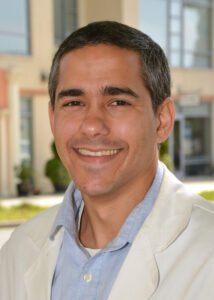����ý researchers Christopher Sayed, MD, Yun Li, PhD, and Karen Mohlke, PhD, discovered the genomic locations that contribute to the genetic risk of a chronic skin condition.
Hidradenitis suppurativa (HS) is a chronic inflammatory follicular disease which causes painful lumps to form under the skin. The lumps typically form in areas where skin rubs together – such as the armpits, groin, and under the breasts. HS can range in severity from occasional fluid-filled abscesses to widespread rope-like scarring, chronic pain, and increase of infection.
The disease is also highly heritable. Historically, researchers have not been able to identify a specific cause or gene for HS, but now researchers at the ����ý have homed in on genetic risk loci – or specific locations on the genome – which contribute to one’s genetic risk of developing hidradenitis suppurativa.
“This discovery is highly relevant because these changes may effect nearby genes in a way that leads to improper development of hair follicles and predispose them to the rupture,” said Sayed. “This results in inflammation and chronic wound formation, which are the classic findings of hidradenitis suppurativa.”
Their research,����JAMA Dermatology, was led by first authors Quan Sun in the Department of Biostatistics and K Alaine Broadaway in the Department of Genetics being the first authors. Sayed was co-senior author, along with Yun Li, PhD, and Karen Mohlke, PhD from the Department of Biostatistics and Department of Genetics, respectively.
Previous studies have shown that as many as 1 person out of every 100 people have the condition, or about 3.5 million people throughout the United States, but the exact number of not known. However, research has shown Black women under the age of 40 have the highest risk of developing HS and are 3 times more likely to have the condition than white people.
The Genome-wide Association Study
To better understand the genetic factors behind HS, the research team performed a genome-wide association study (GWAS). This type of study allows researchers to look at the entire genome to find associations between loci and certain traits, such as chronic diseases.

A total of 720 patients in the Hidradenitis Suppurativa Program for Research and Care Excellence (ProCARE) at ����ý’s Department of Dermatology participated in the study. After collecting saliva and blood samples from patients, the DNA was isolated and taken to the ����ý Genotyping Core, so that researchers could examine the DNA sequences up close to identify differences between people.
As part of the final GWAS, researchers integrated the genetic information from the ProCARE patients with controls from the National Longitudinal��Study��of Adolescent to Adult Health (AddHealth) study – a large longitudinal study of 20,000 adolescents in the United States. Then, researchers combined the results with biological and genetic samples from Finland (FinnGen), the United Kingdom (UK BioBank) and the Vanderbilt University Medical Center (BioVU).
The Loci Behind HS
Through the course of the thorough study, researchers found genetic variants pointing to two genes,��SOX9��and��KLF5, which are thought to play a role in hair follicle and epidermal development. Certain mutations at these loci were more likely to be found in patients with HS than in patients without HS. This is the first report of its kind to successfully identify risk loci for HS.
The gene��SOX9��has two functions in the body: maintaining the structure of the hair follicle and assigning stem cells to become, or differentiate into, the cells that line the hair follicle.��SOX9��also triggers the activation of three other genes:��MMP1,��MMP2, and��IL-8, which are linked to the formation of basal cell carcinomas, melanomas, and inflammation.

The other suspected gene,��KLF5, promotes the generation of keratinocytes – the predominant type of cell within the epidermis – and the secretion of enzymes to eat up dead skin cells. If unchecked, the body produces so much keratin that the epidermis becomes thick and hair follicles can become blocked.
“While more studies are needed to understand how DNA variants near��SOX9��and��KLF5��contribute to the pathophysiology of HS, both genes are potentially highly relevant and have not previously been linked to the condition,” said Mohkle, who is also a member of the ����ý Lineberger Comprehensive Care Center.
Variations in this gene may explain the development of the characteristic cysts, skin-colored bumps, and tunnels that are seen in patients with HS. Where��KLF5��functions to keep epidermal stem cells levels in check,��SOX9��is does the same for hair follicle stem cells.
If this careful balance between the expression patterns is disrupted by genetic factors, it may explain why the body forms chronic wounds such as inflammatory tunnels and ulcers, as well as cysts and epithelialized tunnels.
Potential Overlap with Other Inflammatory Conditions
Researchers also wanted to see if there was a potential overlap with other inflammatory conditions. Through a genetic correlation analysis, they found that inflammatory bowel disease (IBD), psoriasis, and type 2 diabetes may share certain genetic factors with HS. However, further study is needed to evaluate other comorbidities and uncover the biological links between HS and other conditions.

“As is often the case in research, new discoveries lead to many new questions,” said Li. “We plan to expand our work to larger and more diverse cohorts to identify additional HS risk loci.
Moving forward, Sayed and his research team are going to use the genetic basis of HS to inform new potential treatments for the disease. By learning more about how these recently discovered variants and the risk loci affect gene expression and influence the pathogenesis of HS, it may be possible for researchers to suggest novel treatment strategies to mitigate the disease’s effects.
Their additional research objectives include locating additional risk loci in larger patient populations and comprehending how some of those variants may predict the severity and course of the disease.
This research was supported by the National Institute of Arthritis, Musculoskeletal and Skin Diseases through grant R21AR075996.
This article originally appeared in .
